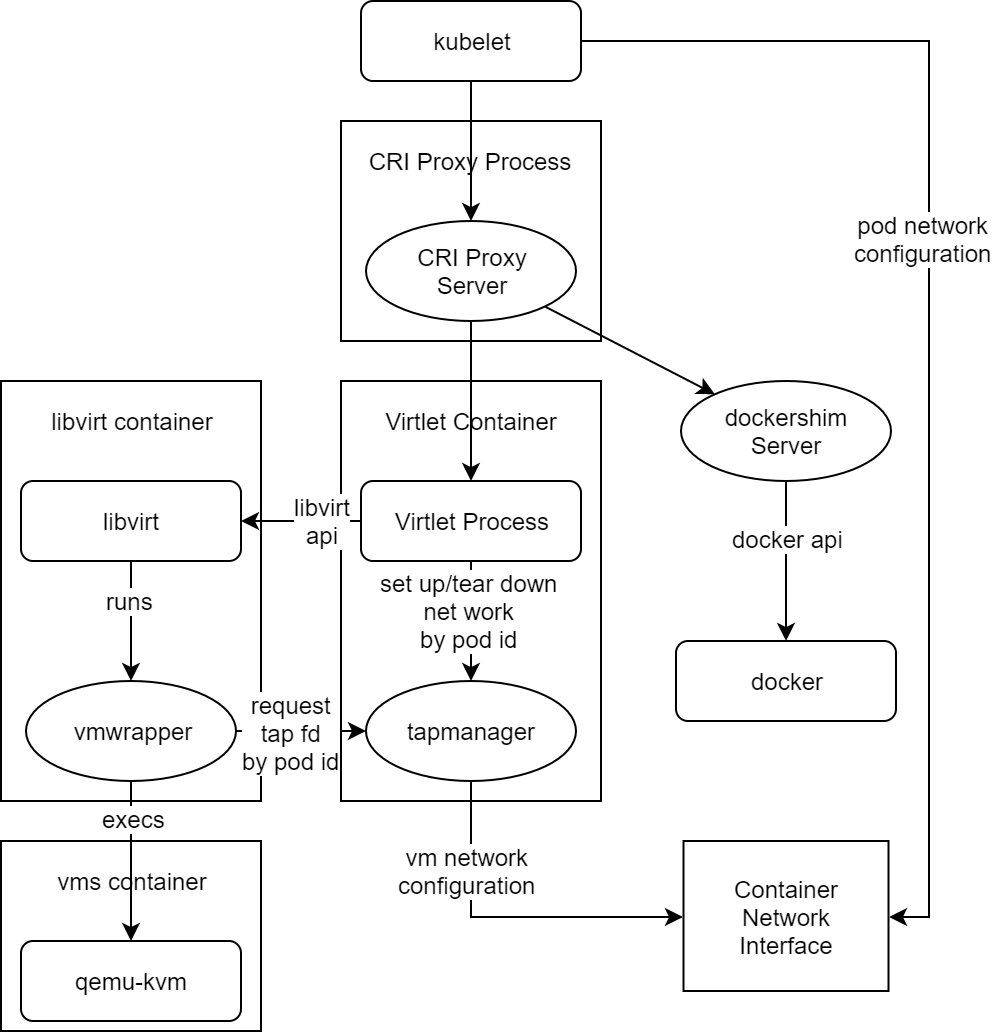Virtlet
what is Virtlet
Virtlet is a Kubernetes CRI (Container Runtime Interface) implementation for running VM-based pods on Kubernetes clusters. (CRI is what enables Kubernetes to run non-Docker flavors of containers, such as Rkt.) For the sake of simplicity of deployment, Virtlet itself runs as a DaemonSet, essentially acting as a hypervisor and making the CRI proxy (Provides the possibility of mixing docker-shim and VM based workloads on the same k8s node) available to run the actual VMs This way, it’s possible to have both Docker and non-Docker pods run on the same node.
Components
- Virtlet manager: Implements the CRI interface for virtualization and image handling
- Libvirt: The standard instance of libvirt for KVM.
- vmwrapper: Responsible for preparing the environment for the emulator
- Emulator: Currently qemu with KVM support (with possibility of disabling KVM for nested virtualization tests)
- ...
VM Pod Lifecycle
Startup
A VM pod is created in Kubernetes cluster.
- Scheduler places the pod on a node based on the requested resources (CPU, memory, etc.) as well as pod's nodeSelector and pod/node affinity constraints, taints/tolerations and so on.
- kubelet running on the target node accepts the pod.
- kubelet invokes a CRI call RunPodSandbox to create the pod sandbox which will enclose all the containers in the pod definition.
- If there's a Virtlet-specific annotation kubernetes.io/target-runtime: virtlet.cloud, CRI proxy passes the call to Virtlet.
- Virtlet saves sandbox metadata in its internal database, sets up the network namespace and then uses internal tapmanager mechanism to invoke ADD operation via the CNI plugin as specified by the CNI configuration on the node.
- The CNI plugin configures the network namespace by setting up network interfaces, IP addresses, routes, iptables rules and so on, and returns the network configuration information to the caller as described in the CNI spec.
- Virtlet's tapmanager mechanism adjusts the configuration of the network namespace to make it work with the VM.
- After creating the sandbox, kubelet starts the containers defined in the pod sandbox. Currently, Virtlet supports just one container per VM pod. So, the VM pod startup steps after this one describe the startup of this single container.
- Depending on the image pull police of the container, kubelet checks if the image needs to be pulled by means of ImageStatus call and then uses PullImage CRI call to pull the image if it doesn't exist or if imagePullPolicy: Always is used.
- If PullImage is invoked, Virtlet resolves the image location based on the image name translation configuration, then downloads the file and stores it in the image store.
- After the image is ready (no pull was needed or the PullImage call completed successfully), kubelet uses CreateContainer CRI call to create the container in the pod sandbox using the specified image.
- Virtlet uses the sandbox and container metadata to generate libvirt domain definition, using vmwrapper binary as the emulator and without specifying any network configuration in the domain.
- After CreateContainer call completes, kubelet invokes StartContainer call on the newly created container.
- Virtlet starts the libvirt domain. libvirt invokes vmwrapper as the emulator, passing it the necessary command line arguments as well as environment variables set by Virtlet.
- vmwrapper uses the environment variable values passed to Virtlet to communicate with tapmanager over an Unix domain socket, retrieving a file descriptor for a tap device and/or pci address of SR-IOV device set up by tapmanager.
- tapmanager uses its own simple protocol to communicate with vmwrapper because it needs to send file descriptors over the socket.
- vmwrapper then updates the command line arguments to include the network interface information and execs the actual emulator (qemu).
Delete
- kubelet notices the pod being deleted.
- kubelet invokes StopContainer CRI calls which is getting forwared to Virtlet based on the containing pod sandbox annotations.
- Virtlet stops the libvirt domain. libvirt sends a signal to qemu, which initiates the shutdown. If it doesn't quit in a reasonable time determined by pod's termination grace period, Virtlet will forcibly terminate the domain, thus killing the qemu process.
- After all the containers in the pod (the single container in case of Virtlet VM pod) are stopped, kubelet invokes StopPodSandbox CRI call.
- Virtlet asks its tapmanager to remove pod from the network by means of CNI DEL command.
- after StopPodSandbox returns, the pod sandbox will be eventually GC'd by kubelet by means of RemovePodSandbox CRI call.
- Upon RemovePodSandbox, Virtlet removes the pod metadata from its internal database.
Virtlet is used to create a virtual machine to support some necessary features needed by ICN. In ICN use case we need IpSec to finish some functions. So using QAT devices to speed up the connections is important. But after tests, I found that virtlet doesn't recognize the qat vf device.
Gaps
- Virtlet considers all other devices bound vfio-pci drivers as a volume device and add them into libvritxml as block disk type with disk driver. This will caused vm startup errors.
- Virtlet binds the network devices after the creatition of libvirt domain file, and its default hostdev id number starts from 0, it will make conflict when we add other type device to libvirt domain file by pci-passthrough
- Virtlet can not recognize other sriov device
- ...
To solve these problems, we should first have a clear knowledge of device plugin.
Device plugin works in kubernetes
